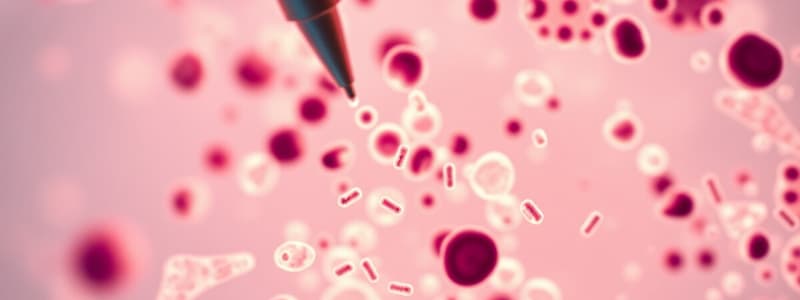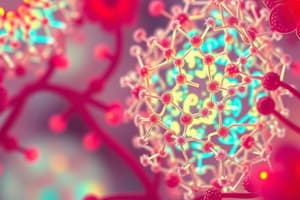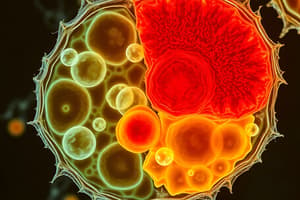Podcast
Questions and Answers
Which symptom is NOT commonly associated with AIDS?
Which symptom is NOT commonly associated with AIDS?
- Weight loss
- Cancers
- Flu-like symptoms (correct)
- Diarrhoea
What role does stomach acid play in the immune system?
What role does stomach acid play in the immune system?
- It kills bacteria. (correct)
- It serves as a physical barrier.
- It activates white blood cells.
- It produces antibodies.
What process allows white blood cells to engulf and destroy pathogens?
What process allows white blood cells to engulf and destroy pathogens?
- Antigen presentation
- Immunization
- Phagocytosis (correct)
- Apoptosis
Which component of the immune system is responsible for the humoral response?
Which component of the immune system is responsible for the humoral response?
What does the release of histamines during inflammation lead to?
What does the release of histamines during inflammation lead to?
Memory cells in the immune system are characterized by:
Memory cells in the immune system are characterized by:
What is the function of lysozymes in the immune response?
What is the function of lysozymes in the immune response?
Specific immune responses are characterized by their reliance on which cells?
Specific immune responses are characterized by their reliance on which cells?
What is the primary function of mitochondria in a cell?
What is the primary function of mitochondria in a cell?
What structure is primarily involved in producing spindle fibers for cell division?
What structure is primarily involved in producing spindle fibers for cell division?
Which component of a prokaryotic cell is responsible for its rigid outer structure?
Which component of a prokaryotic cell is responsible for its rigid outer structure?
What is the main outcome of the mitosis process?
What is the main outcome of the mitosis process?
Which stage of the cell cycle involves the replication of chromosomes?
Which stage of the cell cycle involves the replication of chromosomes?
What type of enzymes do lysosomes contain?
What type of enzymes do lysosomes contain?
What best describes virulence factors in viruses?
What best describes virulence factors in viruses?
What defines the arrangement of cells in multicellular organisms?
What defines the arrangement of cells in multicellular organisms?
What is the main role of cholesterol in the cell membrane?
What is the main role of cholesterol in the cell membrane?
Which process requires energy in the form of ATP?
Which process requires energy in the form of ATP?
What type of molecules can achieve movement through the phospholipid bilayer via diffusion?
What type of molecules can achieve movement through the phospholipid bilayer via diffusion?
In facilitated diffusion, what is required for transportation across the membrane?
In facilitated diffusion, what is required for transportation across the membrane?
Osmosis is defined as the diffusion of which molecules?
Osmosis is defined as the diffusion of which molecules?
What process uses vesicles to transport particles into the cell?
What process uses vesicles to transport particles into the cell?
Which statement correctly describes co-transport in epithelial cells of the ileum?
Which statement correctly describes co-transport in epithelial cells of the ileum?
What is the primary function of glycoproteins in the cell membrane?
What is the primary function of glycoproteins in the cell membrane?
What role do T helper cells play in the immune response?
What role do T helper cells play in the immune response?
What is the primary function of antibodies?
What is the primary function of antibodies?
Which type of immunity results from the introduction of antibodies from another person or animal?
Which type of immunity results from the introduction of antibodies from another person or animal?
Which scenario best describes natural active immunity?
Which scenario best describes natural active immunity?
What happens during the agglutination process involving antibodies?
What happens during the agglutination process involving antibodies?
What is the primary limiting factor for the resolution of light microscopes?
What is the primary limiting factor for the resolution of light microscopes?
What is a primary factor determining the success of a vaccination program?
What is a primary factor determining the success of a vaccination program?
Which of the following statements accurately describes transmission electron microscopes (TEM)?
Which of the following statements accurately describes transmission electron microscopes (TEM)?
What characteristic of antibodies allows them to mark cells for destruction by phagocytes?
What characteristic of antibodies allows them to mark cells for destruction by phagocytes?
What is the maximum resolving power of light microscopes compared to electron microscopes?
What is the maximum resolving power of light microscopes compared to electron microscopes?
What is the outcome of a vaccination in terms of immunity?
What is the outcome of a vaccination in terms of immunity?
Which characteristic is true for both transmission electron microscopes (TEM) and scanning electron microscopes (SEM)?
Which characteristic is true for both transmission electron microscopes (TEM) and scanning electron microscopes (SEM)?
Which is a disadvantage of using scanning electron microscopes (SEM)?
Which is a disadvantage of using scanning electron microscopes (SEM)?
What is the formula used to calculate magnification in microscopy?
What is the formula used to calculate magnification in microscopy?
What factor leads to the requirement for specimens to be very thin in transmission electron microscopy?
What factor leads to the requirement for specimens to be very thin in transmission electron microscopy?
Which of the following describes a benefit of using electron microscopes over light microscopes?
Which of the following describes a benefit of using electron microscopes over light microscopes?
Why are unvaccinated individuals often protected in a vaccinated population?
Why are unvaccinated individuals often protected in a vaccinated population?
What characteristic of the Influenza virus complicates long-term immunity?
What characteristic of the Influenza virus complicates long-term immunity?
Which ethical concern is associated with vaccine production?
Which ethical concern is associated with vaccine production?
What is one application of monoclonal antibodies in cancer treatment?
What is one application of monoclonal antibodies in cancer treatment?
How do monoclonal antibodies assist in HIV diagnosis?
How do monoclonal antibodies assist in HIV diagnosis?
What role does reverse transcriptase play in HIV replication?
What role does reverse transcriptase play in HIV replication?
Which of the following is NOT a reason why vaccines may fail to prevent disease outbreaks?
Which of the following is NOT a reason why vaccines may fail to prevent disease outbreaks?
What can happen to monoclonal antibodies when used in indirect therapy?
What can happen to monoclonal antibodies when used in indirect therapy?
Flashcards
Resolution
Resolution
The ability of a microscope to distinguish between two objects that are close together.
Resolving Power
Resolving Power
The minimum distance apart that two objects can be distinguished as separate objects in an image.
Electron Microscope
Electron Microscope
A type of microscope that uses a beam of electrons to illuminate a specimen.
Transmission Electron Microscope (TEM)
Transmission Electron Microscope (TEM)
Signup and view all the flashcards
Scanning Electron Microscope (SEM)
Scanning Electron Microscope (SEM)
Signup and view all the flashcards
Magnification
Magnification
Signup and view all the flashcards
Light Microscope
Light Microscope
Signup and view all the flashcards
Resolution Limit of Light Microscopes
Resolution Limit of Light Microscopes
Signup and view all the flashcards
Mitochondria
Mitochondria
Signup and view all the flashcards
Centrioles
Centrioles
Signup and view all the flashcards
Ribosomes
Ribosomes
Signup and view all the flashcards
Lysosomes
Lysosomes
Signup and view all the flashcards
Mitosis
Mitosis
Signup and view all the flashcards
Interphase
Interphase
Signup and view all the flashcards
Cytokinesis
Cytokinesis
Signup and view all the flashcards
Cell division-mitosis
Cell division-mitosis
Signup and view all the flashcards
Humoral Response
Humoral Response
Signup and view all the flashcards
Cell-mediated Response
Cell-mediated Response
Signup and view all the flashcards
Antibodies
Antibodies
Signup and view all the flashcards
Agglutination
Agglutination
Signup and view all the flashcards
Active Immunity
Active Immunity
Signup and view all the flashcards
Passive Immunity
Passive Immunity
Signup and view all the flashcards
Vaccine
Vaccine
Signup and view all the flashcards
Herd Immunity
Herd Immunity
Signup and view all the flashcards
Skin as a barrier
Skin as a barrier
Signup and view all the flashcards
Lysozyme
Lysozyme
Signup and view all the flashcards
Phagocytosis
Phagocytosis
Signup and view all the flashcards
Histamines
Histamines
Signup and view all the flashcards
Antigens
Antigens
Signup and view all the flashcards
Non-Specific Immune Response
Non-Specific Immune Response
Signup and view all the flashcards
Memory Cells
Memory Cells
Signup and view all the flashcards
Specific Immune Response
Specific Immune Response
Signup and view all the flashcards
Passive Diffusion
Passive Diffusion
Signup and view all the flashcards
Bulk Transport (Endocytosis & Exocytosis)
Bulk Transport (Endocytosis & Exocytosis)
Signup and view all the flashcards
Active Transport
Active Transport
Signup and view all the flashcards
Osmosis
Osmosis
Signup and view all the flashcards
Facilitated Diffusion
Facilitated Diffusion
Signup and view all the flashcards
Co-transport
Co-transport
Signup and view all the flashcards
Membrane Proteins
Membrane Proteins
Signup and view all the flashcards
Cholesterol
Cholesterol
Signup and view all the flashcards
Antigenic Variation
Antigenic Variation
Signup and view all the flashcards
Monoclonal Antibodies
Monoclonal Antibodies
Signup and view all the flashcards
Indirect Therapy Using Monoclonal Antibodies
Indirect Therapy Using Monoclonal Antibodies
Signup and view all the flashcards
HIV Replication
HIV Replication
Signup and view all the flashcards
Reverse Transcriptase
Reverse Transcriptase
Signup and view all the flashcards
HIV Attachment Proteins
HIV Attachment Proteins
Signup and view all the flashcards
Pregnancy Testing and Monoclonal Antibodies
Pregnancy Testing and Monoclonal Antibodies
Signup and view all the flashcards
Study Notes
Microscopy Techniques
- Light microscopes use light to resolve images 0.2 µm apart. Resolution is limited by the wavelength of light.
- Magnification = size of image/size of real object.
- Resolution is the minimum distance between two objects that can be distinguished. Higher resolution means a clearer image.
- Electron microscopes use a beam of electrons, allowing resolution of objects closer than 0.2 µm.
- Transmission electron microscopes (TEM) examine thin sections of specimens to see internal structures.
- Scanning electron microscopes (SEM) examine the surface of a specimen to produce 3D images.
- Limitations of electron microscopes include the need for a vacuum environment and complex staining processes, which can introduce artefacts.
Cell Fractionation
- Cell fractionation is a technique to separate cellular components for detailed study.
- Differential centrifugation is a common method.
- Homogenization is the initial process of blending cells to form a homogenate.
- Centrifugation spins the homogenate at increasing speeds to separate organelles by density.
- Heavier organelles settle first, then lighter ones.
- Organelles are collected in pellets.
Cell Structure
- Eukaryotic cells have a nucleus and membrane-bound organelles.
- Nucleus contains chromatin and nucleolus (ribosome production).
- Rough endoplasmic reticulum (RER) has ribosomes attached and processes proteins.
- Smooth endoplasmic reticulum (SER) processes lipids.
- Golgi apparatus processes and packages proteins & lipids.
- Lysosomes contain digestive enzymes.
- Mitochondria have a double membrane with cristae, where respiration occurs.
Prokaryotic Cells
- Prokaryotic cells (e.g., bacteria) lack a nucleus and membrane-bound organelles.
- Cell wall, capsule, plasmid, flagellum, pili, and ribosomes are important prokaryotic components.
- Mesosomes are infoldings of the cell membrane that contain enzymes for respiration.
Cell Division - Mitosis
- Mitosis is cell division that produces genetically identical daughter cells for growth and repair.
- Mitosis occurs in four stages: prophase, metaphase, anaphase, and telophase.
- Interphase describes the cell cycle phases before mitosis, where DNA replicates.
- Cytokinesis is the division of the cytoplasm.
- Binary fission is the process of prokaryotic cell division.
Biological Membranes
- Membranes are composed of a phospholipid bilayer with embedded proteins.
- Functions include controlling movement of substances, receptor functions, and cell adhesion.
- Components of membranes include phospholipids, cholesterol, glycolipids, and glycoproteins.
Cell Transport
- Passive transport includes diffusion (small, nonpolar molecules), facilitated diffusion (polar molecules with transport proteins), and osmosis (water).
- Active transport moves substances against their concentration gradient using energy.
- Exocytosis & endocytosis transport large molecules.
- Co-transport couples the movement of one substance with another across a membrane.
Bacteria and Viruses
- Bacteria are prokaryotic cells with a cell wall and DNA.
- Viruses are non-living particles with genetic material (DNA or RNA) enclosed in a protein coat.
- Viruses depend on host cells to replicate.
Immunity
- Physical barriers prevent infection (skin, stomach acid).
- Non-specific immunity (inflammation, lysozyme, phagocytosis) responds to pathogens generally.
- Specific immunity responds to antigens with B and T lymphocytes.
- B cells produce antibodies (humoral response)
- T cells attack infected cells (cell-mediated response).
- Memory cells allow faster response to repeated infections.
Vaccines
- Vaccines introduce antigens to stimulate an immune response without causing disease.
- Active immunity (vaccines/natural infection) involves the body producing antibodies.
- Passive immunity (antibody injection/mother's milk) involves receiving antibodies.
- Factors affecting vaccine success include cost, side effects, and ease of administration.
Ethical Considerations
- Ethical concerns regarding vaccine production, testing on animals/humans, and compulsory measures should be addressed.
- Herd immunity occurs when a significant portion of the population is immune, limiting spread of disease.
Monoclonal Antibodies
- Monoclonal antibodies are identical antibodies produced against a specific antigen.
- Applications include cancer therapy, diagnosis, and pregnancy tests.
HIV
- HIV is a retrovirus causing AIDS.
- HIV has a lipid envelope, capsid, and RNA genetic material with reverse transcriptase enzyme.
Antibiotics and Viruses
- Antiretroviral drugs target HIV's replication process, but antibiotics are ineffective against viruses (as they lack cell walls).
- ELISA methods can detect specific HIV antigens.
Studying That Suits You
Use AI to generate personalized quizzes and flashcards to suit your learning preferences.
Related Documents
Description
Explore the fascinating world of microscopy techniques and cell fractionation. Learn about light and electron microscopes, their resolution capabilities, and the processes involved in cell fractionation, including differential centrifugation. This quiz will help you understand key concepts and applications in biological microscopy.




